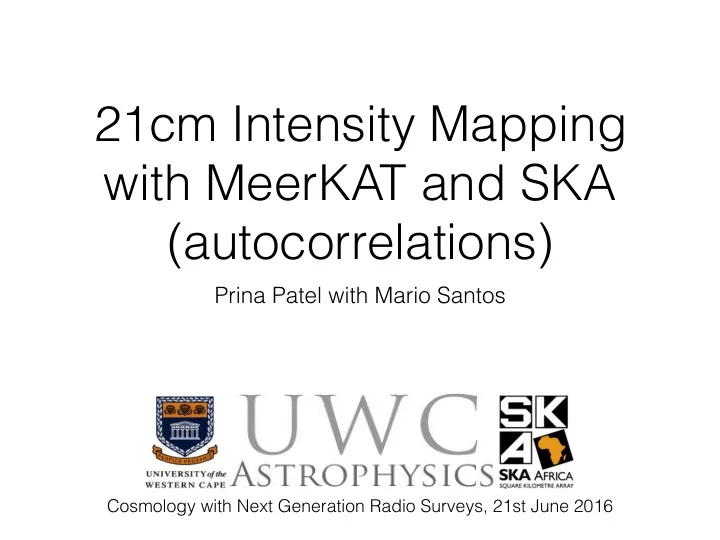

21cm Intensity Mapping with MeerKAT and SKA (autocorrelations) Prina Patel with Mario Santos Cosmology with Next Generation Radio Surveys, 21st June 2016
HI Intensity Mapping? Galaxies Intensity Map • Look at the total intensity of a given emission line (21cm in our case) in a large 3d pixel (angle and frequency). • Each pixel combines the emission of multiple galaxies.
Why HI IM? HI galaxy surveys are expensive: SKA1 ~ 10 7 galaxies over 5,000 deg 2 SKA2 ~ 10 9 galaxies over 30,000 deg 2 Santos et al., 2015 Cheap way to observe large volumes since you don’t need to resolve individual galaxies - ideal for cosmology
Current/Planned BINGO, Uruguay HIRAX, South Africa GBT, USA CHIME, Canada
MeerKAT 64 dishes in the Karoo, 20 dishes in place, 16 with receivers fitted and operational as an interferometer in the next few months Precursor that will be incorporated into SKA1-Mid
MeerKLASS MeerKAT final specs deliver great survey speed (large primary beam and low noise) HI Intensity mapping, cosmology and lots of other stuff ~4000 square degrees, 6 microJy rms noise (~4000h) Crucial stepping stone for run up to SKA (especially for intensity mapping)
SKA • Interferometer baselines not small enough to probe BAO scales, so have to use in single dish mode…also only way to get very largest scales • Phase 1: ~190 dishes + 64 MeerKAT, ~2023 • Proposal to provide calibrated autocorrelations approved by the SKA office 15m SKA Dishes
BAO with MeerKAT? Possible detection of BAO with intensity mapping Using only autocorrelations Credit: Amadeus Witzmann
BAO with SKA? SKA1 Intensity mapping comparable to EUCLID galaxy survey for measuring the BAO wiggles. z~0.5 z~1.8 Bull et al., 2014
Why is IM hard? Foregrounds Orders of magnitude larger than signal Several contributors T [mK] BUT spectrally smooth
Foregrounds are smooth in frequency Fluctuations in the instruments and their coupling to the foregrounds make cleaning much harder Cross-correlation with other surveys (e.g. MeerKAT/ DES, SKA/LSST/EUCLID) can also help with this, as demonstrated by the GBT team Alonso et al., 2014
Noise ◆ 2 ! 0 . 5 ✓ ∆ G 1 ∆ T = T sys ∆ t ∆ ν + G White/thermal Pink - 1/f noise noise ◆ 2 ✓ ∆ G Can model the gain = γ 0 + γ 1 t fluctuations in time as: G 1 Integration time Integrating longer than this t = √ γ 1 ∆ ν sweet spot: means the 1/f dominates
Power Spectrum in Time… White noise Power Spectrum ∝ 1 /f At knee frequency pink and white Pink noise contribution are equal White f f knee
Testing the calibration of autocorrelations with Noise Injection using KAT7 and MeerKAT
KAT7 Data Drift scan observation ~30 mins of useable data with 1 second integration Noise diode fired every 3 minutes Can we calibrate the autocorrelation to reach T RMS =48mK? 30K T sys T rms = 1s ⇥ 390 . 625kHz = 48mK p p ' ∆ ντ
In time… In frequency…
Deriving Gains I N = G ( S + N ) When the noise diode is firing I = GS When it’s not G = I N − I Solution N 10s Noise diode model 180s 10s
Corrected Data 30 Minutes 80 MHz Starting point for foreground cleaning
Foreground Cleaning (Along the frequency direction) Spectral smoothness - fit smooth things to each timestamp. We looked at 3 different approaches: Wiener filtering, Gaussian Processes and SVD. Are residuals noise like?
Wiener Filtering: Leaves a very distinct signature in frequency that appears very constant in time
30K = 0 . 048k T RMS ' p ∆ t ∆ ν Subtract off this very constant pattern and you’re left with noise like residuals (but rms level is below the expected noise)
Gaussian Processes Much more contamination is removed, but still not perfect!
Maybe we can improve this? Large scale structure still remains
Factor data matrix A : A=USV SVD U,V - unitary S - Singular values of A Find that with the removal of 3 components we get noise like residuals
MeerKAT Data - 1/f SCP Data with different dump rates, all below 1 second 100 second observations knee ~ 0.2 Hz, 5 sec
Move the knee Move the knee f knee with filtering in frequency 20sec
10Hz data SVD - remove two top modes - looks pretty white! 1/f seems to be mostly in the top 2 modes Drifts in time = 1/f (Thanks to Jon Sievers)
More MeerKAT Data Noise injection data to be analysed: noise diodes are available on every dish (very stable: <0.04% RMS over 20 minute intervals) Longer observations requested for testing the 1/f stability Scan data with noise injection and sky calibrator also in the works
Conclusions A large survey with MeerKAT will detect the BAO signal in HI (as well as other science) Exploring foreground cleaning methods with autocorrelation data from KAT7 & MeerKAT Looking at how to achieve the optimal 1/f More MeerKAT data in the pipeline Everything is a crucial step towards SKA1
Recommend
More recommend